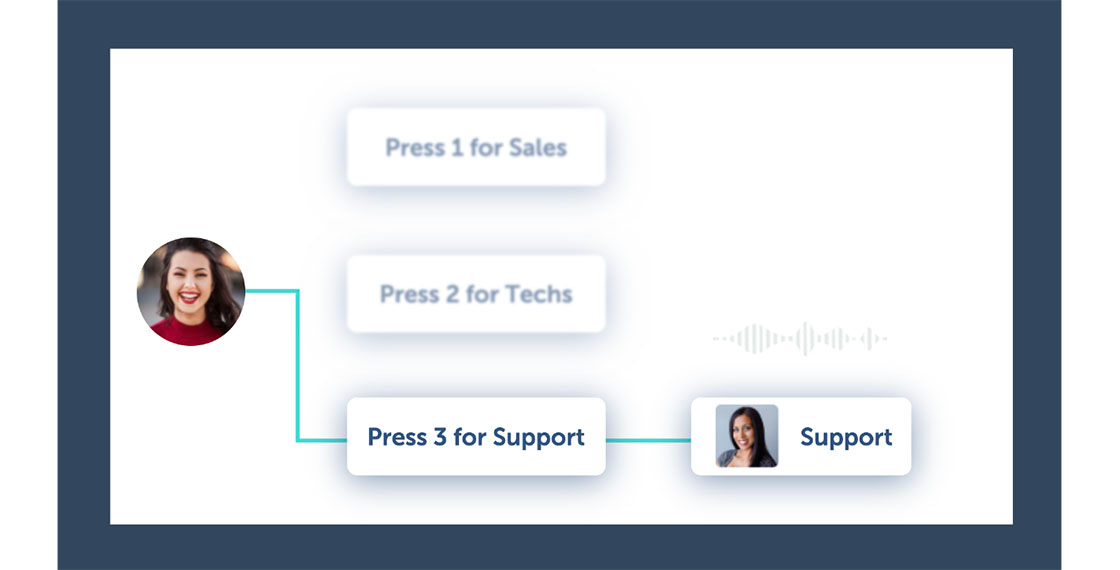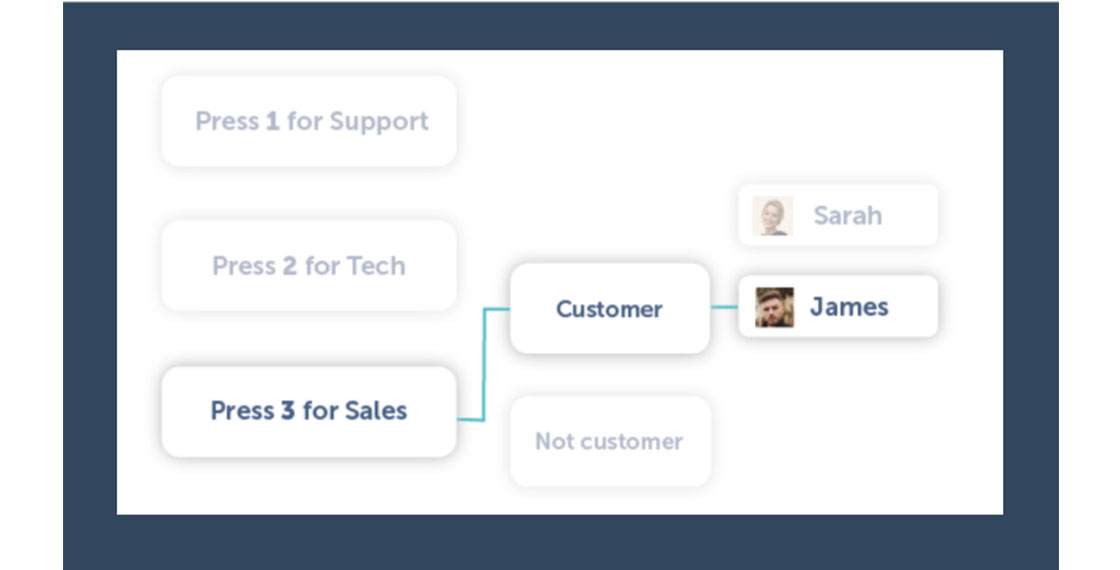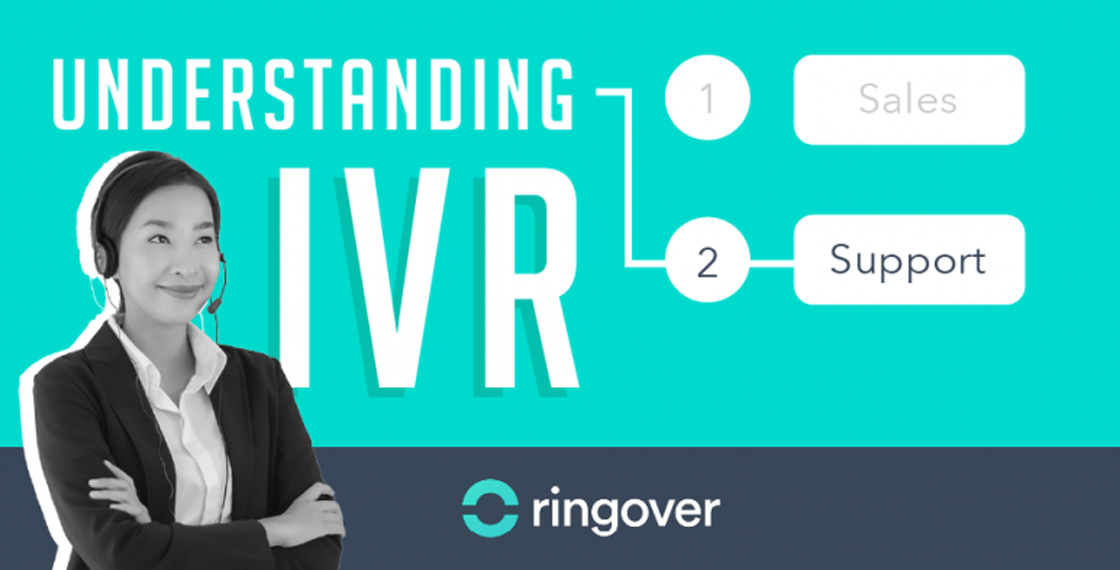Summary
When we think of communicating by phone we usually mean one human voice to another, mediated by the telephone network, which simply transmits the sounds from the microphone to the speaker in the other party’s headset. However, modern business telephone systems are capable of more flexible and multilayered ways of communicating.Indeed, Interactive Voice Response (IVR) has been around for a lot longer than modern VoIP telephone systems like Ringover, because for decades the phone has carried other sounds than voice — such as the unique tones of the beeps that were introduced with the first touch-tone phones, back in the 1980s, which enabled callers to interact in a limited way before a human recipient was connected. By standardising the frequencies associated with each number, (in each case actually a pair of frequencies defined by the Dual-tone multi-frequency signalling protocols of AT&T), it meant that the destination phone system could operate a rudimentary self-service switching system along the lines of ‘press 1 for accounts, press 2 for support’, etc, or direct-dial an extension number after being connected to a call.Nowadays IVRs can be used to provide complex and nuanced responses to the human voice as well as to keypad input, and they form a vital front-door to contact centres, deploying queuing and routing solutions to get the caller to the right place fast. Increasingly today sophisticated AI-driven algorithms with the power of natural-language processing are leading to an ever-greater range of caller-driven interactions, which can take place without the involvement of any human operator.The article highlights key benefits of IVR that make it so vital to creating seamless self-service experiences:
1. Benefits for callers of an IVR

The development and deployment of IVRs in contact centres has led to a number of benefits for customers getting in touch with a business, whether for sales or support.
No more waiting
“Your call is important to us”, the recorded messages always reassured us. But when left hanging on hold, listening to irritating music and repeated messages, it didn’t make anyone feel very special. I remember my bank used to have a specially annoying feature of interrupting the hold music abruptly, so you really thought the call had at last connected — only to repeat a message about how much they valued me as a customer. I certainly didn’t feel valued.And during times of unexpected demand, such as during a product recall or local emergency, holding a place in the queue to speak to someone can still mean hanging on for hours - wasting time and running bills and frustration levels up and batteries and patience down. Of course there are times where there’s a mismatch between the number of callers and the number of agents available to answer, but an IVR can fix that easily.
Round-the-clock service

Now I can call my bank at any time of the day or night, and easily access information about my balances and transactions via voice command, and through entering security numbers on the keypad. I can even order new products and services, without the need to talk to a human at all. And if I do need to talk to somebody I can usually do that much more quickly, because they’re not wasting time checking people’s balances for them and reading things out off a screen. With a few taps or replies I can reach a specialist agent with knowledge of my situation or need, who can help me sort out my difficulties fast.
People don’t always want to talk
Many clichés have a ring of truth to them, but for some that’s less disturbing than a ringing phone — and the evidence bears out the idea that growing numbers of digital natives prefer not to have a human-to-human conversation anyway. Of course behind the headlines lie greater nuances, but the fact is that growing numbers of people from all generations are increasingly happy to solve their own customer service problems without recourse to another person, they just need the right information and guidance to do so. Even if they don’t have hang-ups and anxiety about speaking to a stranger, people can be embarrassed about whatever their difficulty is, or might have language or communication problems. Perhaps they’re feeling awkward that they’re being uniquely stupid in having a certain query or problem, but then when an IVR prompts them about it specifically they realise they’re far from alone in their confusion.
2. Benefits of an IVR for businesses
Of course anything which makes customers happier is good for business — improving lifetime customer value, net promoter score, and many other sales metrics which directly influence the bottom line. But there are other benefits too for enterprise, which might be less obvious to their users, including:
Saving costs on contact centre staff
Whatever technology a contact centre has deployed, its greatest direct cost is the hours provided by human agents. Managing this cost requires tricky predictions of call volumes, to strike a balance between the downtime agents spend waiting between one call and the next, compared with making customers wait in line to be attended to.If a significant proportion of inbound enquiries can be abstracted away to an automated process, that means high response rates can be maintained with minimal agent hours. And in the event of an emergency or unusual level of demand, a thoughtfully configured IVR will help teams of any size strike the best balance between routing inbound callers to the next best person in the fastest time, or offering them the option to receive a call back rather than wait.
More interesting and specialised contact centre roles
Before the kind of decision-trees that IVRs use were embedded in the telephone system itself, human agents actually operated this kind of routine themselves on behalf of the customer — tap here to obtain the customer’s balance and read it out, see this support note if they are having X kind of problem operating the product, run through this questionnaire to generate a quote, and so on.This meant boring and very routine, badly paid work, in what were often described as ‘white-collar-factories’. These were frequently offshored to distant lands where labour was cheap and accents could be challenging. Long shifts, hard-wired headsets, and random supervision and recording of calls, all combined to create a high-turnover and deeply unrewarding career path for many customer service agents.Nowadays, agents have a new team member in their IVR system — a colleague who deals with all the boring and repetitive calls for them, with greater consistency and speed than they ever could. Anything which follows an ‘if this, then that’ logical pathway can be dealt with entirely by the automated response, without ever bothering them.So the humans are left to engage with the more complex and demanding calls, and not just calls — today’s contact centres are increasingly omni-channel, multimedia experiences. When a caller is escalated for their attention it might be because they’re upset or having difficulty expressing themselves, or that they have a unique and unusual situation or problem. They’ll need to engage skills of empathy and active listening, and have the opportunity to make a real difference to the customer personally — as well as helping the brand they work for be more likely to benefit from positive recommendations as a result.

Whatever the size of your company, an IVR can help your image and credibility, while managing caller expectations and your own time and resources. Even a sole trader can screen their calls through a simple IVR menu — press one for accounts, press 2 for sales, and so on — to enable them to decide whom to answer when, as well as implying a larger team is on hand. Meanwhile it ensures that no caller simply hits a busy tone, which creates frustration for them as well as confirming that you are indeed a one-person enterprise with a single line available.
3. Highly flexible and user-configurable systems
As you may imagine, an IVR is a very effective tool at the disposal of your business, and its strength lies in how you set it up in the first place. Connecting your phone system, software applications, product databases and your CRM, along with knowledge of your team’s availability and specialisms, sounds like a daunting task - but it need not be.
Define the pathway

Ringover’s multi-level IVR has an intuitive visual interface, enabling you to design and deploy the perfect customer journey for your inbound calls. You can set it up in the dashboard then tweak it at leisure, taking advantage of the combined power of features like:
- Transfer to users — put the caller straight through to the person they need to speak to
- Transfer to groups — add them to a queue for fastest attendance from the next available responder, for example a technical support pool
- Transfer to an announcement — to explain a specific situation or set of circumstances, such as a recording of office opening hours or procedures to follow
- Transfer to external numbers — to forward to an out-of-hours answering service, or a back-up emergency coverBy combining these options with considered and regularly updated recorded messages, your inbound callers will always know they’re on the right path to resolving their needs rapidly and responsively.

Connect your IVR and your CRM
You can also set additional preferences on many of these layers, such as when transferring to a group of sales agents, by integrating your Ringover IVR with your choice of CRM (customer relationship management) tool. That enables the intelligence therein to be combined with the power of the switching system through Ringover Priority Routing, to accomplish subtle call management goals — for example connecting them by preference with the agent who last dealt with them, to ensure the personal touch and sense of continuity.This is just one choice available, and if your style of communication includes many calls rather than an infrequent sales process, it might make more sense that your IVR first tries to connect them with the agent they have had the most contact with, prioritising the enhancement of that relationship first of all, because ‘people do business with people’. If that agent is unavailable, they can be immediately routed to the person they last dealt with, or to any available agent. They can even be allocated to the agent who has received the fewest calls in that period — it’s totally up to you how you configure it, but the point is that the caller has no idea. They simply select ‘sales’ — and it’s up to you, as the system admin, to decide in advance how that call is handled.4. Data-driven automation
What the use of an IVR like Ringover can offer therefore is a very complex and responsive tool for engaging with callers in the way that best serves your business. You know that business better than anybody else does, and you can combine the analytics from your Ringover calling system with all your other data, to make evidence-based decisions, that drive your business forward.For example, you might be starting to achieve a more international client base as your brand recognition grows, and wondering whether you’re losing out on business due to having customers out of your time zone:Your IVR can provide data on call volumes around the clock, and how many missed calls go on to leave a message, what path they take through the automated information on offer to them. This is highly valuable information, but, if you combine it with your business intelligence regarding lifetime customer value and your inbound call conversion rate, you can calculate the cost of each out-of-ours call, and run that against the additional expense of employing a night answering in-house team, or outsourcing this cover to an external agency. If your volumes make it realistic, you could even split-test this — have half the calls diverted to the low-cost external agency, and half to voicemail, for example, to see which option does the most to improve profitability over a fixed period.The data served up by your IVR therefore forms a critical part of your business analytics, helping you remain competitive and relevant whatever the economic climate and environment.
If your volumes make it realistic, you could even split-test this — have half the calls diverted to the low-cost external agency, and half to voicemail, for example, to see which option does the most to improve profitability over a fixed period.The data served up by your IVR therefore forms a critical part of your business analytics, helping you remain competitive and relevant whatever the economic climate and environment.
5. IVRs and customer expectations — the future
IVR is now a ubiquitous part of business telephony, and by 2018, more than 86% of contact centres were making use of some kind of IVR system. However, it’s important to appreciate the very diverse range of solutions on the market and how far the technology has evolved since its inception. Furthermore it’s also vital to understand that customer expectations have similarly evolved, and tolerance has declined for overly complex and repetitive menus which take ages to navigate, and might have unclear or ambiguous routings… press 1 of this then 2 for that and 3 for the other, and can you even remember how you got to this part? Never mind, is it clear how to escalate out of this button pressing hell and speak to a real human?Operating your IVR as part of a subscription service through Ringover ensures your customers always receive the most up-to-date and reliable system to interact with, and that you as the administrator always have access to the most intuitive and powerful toolset with which to configure and test it.As IVRs become ever-more powerful, particularly in the sphere of voice and sentiment recognition, it will make even better sense to use a system designed to bring you the best of managed business telephony with automation embedded.Want to learn how an IVR can support your business?
Contact our experts to help guide you step-by-step at +44 20 3808 5555 or send an email to [email protected]. Start your free trial today.
Published on April 21, 2020.

